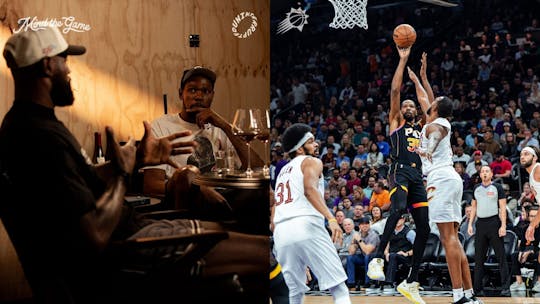Kevin Durant isn’t campaigning to end the three-point revolution. But he’s making a clear case for why the midrange jumper still matters — especially when the game is on the line.
The two-time champion spoke at length about the evolving role of the midrange shot in the modern-day NBA in the latest episode of the Mind the Game podcast with Lakers star LeBron James and Hall of Famer Steve Nash.
“The midrange game is coming back for sure,” Durant said.
In a league obsessed with threes and layups — the “math shots” favored by analytics departments everywhere — that statement felt like a quiet rebellion.
But Durant wasn’t pushing back on numbers for the sake of nostalgia, as the discussion centered around how playoff basketball doesn’t care about shot charts.
As the 2014 MVP puts it, the ‘math’ changes when the ball is in elite hands.
“We should look for the good shots early — threes, attacking the paint, layups. But when there’s five or six seconds left, get the ball to the best player. And if he shoots a midrange at that point, then he shoots a midrange,” the 36-year-old insisted.
Durant has long been one of the league’s most efficient scorers. Since 2020, he’s shot over 41% from 3-point range, though he averages only 5.5 attempts per game.
By comparison, former Rockets guard Jalen Green — who was sent to Phoenix in the Durant deal — averaged 8.4 three-point attempts last season while shooting just 35.4%.
Despite the ongoing emphasis on spacing and shot efficiency, the 15-time All-Star believes the best players need flexibility in the half court, especially late in the shot clock when defenses are more focused on preventing layups and threes.
“You can’t tell LeBron, Luka, or Austin Reaves not to take those midrange shots. Just be you. But certain guys, who can’t create on their own — they need to stick to the system. They need to shoot the threes,” Durant continued.
He even recalled a moment during a game last season when Cleveland’s Georges Niang encouraged him to launch more threes instead of feasting in the midrange.
“I said, ‘No, these dudes around me need to shoot more threes. I need to play my game. If I get into the paint and y’all collapse, I’m kicking it out expecting them to shoot — not dribble into a midrange. That don’t make no sense. The best players on the team — you can’t turn them into role players,” Durant elaborated.
Nash echoed the sentiment, arguing that the midrange never truly disappeared — it was just waiting for the right players to bring it back.
“The midrange has never been more important, but it has to come from the right dudes,” the two-time MVP bared.
Even James admitted that the midrange game, while effective, remains one of the more difficult aspects of his offensive skill set to master.
“Even though I work on all of them, when you get into the fray, you don’t want the defense to dictate what you want to do. It’s something I haven’t been able to master,” the four-time champion revealed.
As for Durant, his philosophy is rooted in logic more than nostalgia.
When the game slows down, the shot clock dwindles, and the ball finds the best player’s hands — the midrange is no longer the shot to avoid. It’s the shot to win with.
“It’s that simple,” Durant emphasized.




